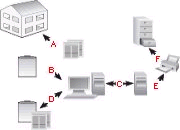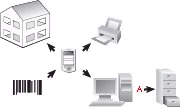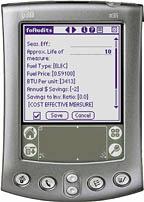Where the Heck is the Audit?
by Bill Shadish
Figure 1. The normal paper shuffle. An audit (a) is taken in the building, which is moved (b) to the computer, and then to the office server (c). It is then generated as a paper work order (d), printed (e) and stored away (f).
Figure 2. The wireless approach. There is potentially one move of paper (a) to a file cabinet.
I just do NOT know where the heck it is!" Jim mutters to himself, while rifling through his case. Finally, with a pile of crumpled papers stuffed into one hand, he turns to his boss and says "I'm sorry Bob, but I think that I lost page 2 of Building B's audit at the site yesterday."Jim's supervisor, Robert Langhorne, shakes his head. He is really not all that surprised. This is the third time this month that Jim has either lost an audit form or that there have been problems in entering his audit information back at the office.
More often than Bob prefers, it is even difficult to simply read Jim's handwritten notes at all. These notes about the job site are the key to conveying meaningful, customized information to the client. This makes the notes extremely important but not very useful when others in the office try to make use of them.
And [Bob shudders] Jim is one of his better inspectors.
Been there, Lost that?
Bob knows that the audits have been run this way for years. He also realizes that the complexity of Jim's relatively small-sized commercial audit (after all, building B was simply the storage area of a little bakery) in no way compares to the far more complex and technically integrated large commercial audits. These are the same large audits where tiny variances in calculated amounts, can mean tens of thousands of dollars of differences in energy cost calculations.
Having just inherited this mess from a happily retiring peer (as well as the task of improving the process), Bob wonders where to start. He continues to question if there is a better way "out there" of doing commercial audits.
Paper Flow Overflow
Figure 3. Palm audit
Energy industry professionals who have worked with energy field audits for commercial buildings have probably all felt like Bob Langhorne from time to time. Many audits are still conducted on paper and re-entered into office computer systems.When a company goes on to perform work at the site, it first needs to conduct an audit, then the work itself, and finally an inspection to see if everything was done properly. Frequently this requires several trips back and forth to the building being worked on.
If all goes well, the inspection process will not result in a punch list of corrective work to be done. A punch list would mean performing the whole work-through-the-inspection process all over again.
Depending upon scheduling, there may be more than one trip to the building site involved, with various pieces of paper forms trickling back to the office from each visit to the site.
If the process is paper based, it is likely that the auditors carry audit forms with them. These audit forms will have to be passed to the contractors to complete the work. Of course, those same forms must make their way to inspectors, so that they can see what work the contractors have done, before doing an inspection. All of this contributes to considerable time and cost as the paper moves between the different steps in the process.
Contracting out auditing, contracting, or inspections makes the process much more complicated because of the need to interact with another company.
A Better Mousetrap
Many experienced auditors feel that paper is the only way to go. Some reject the idea of electronic input outright. However, as more and more energy consultants use technology to capture audit information, the pressures of competition may dictate at least considering the use of (non-paper) tools.Figure 1 shows the audit workflow using a paper-based process. Figure 2 shows the same workflow using wireless handheld devices, such as a Palm Pilot. Such tools allow field staff to communicate with their central office systems wirelessly.
The use of wireless devices reduces trips to the customer site. An auditor can audit a site, creating work orders on site. The work orders can be approved (or adjusted) from the office remotely and assigned to contractors already at the work site. Depending upon the amount of work to be done, inspectors can review what has been done, verify it, or produce punch lists, all without moving paper back and forth to the office. In the more rural areas of the country-reducing the paper travel can contribute to significant savings.
The use of wireless devices greatly reduces the number of errors that occur when moving information from paper into office systems. If information does not have to be keyed in at the office, or rekeyed, the possibility of data transcriptions, or flat out errors, and all of the time that goes into looking for and correcting these errors, drops.
The wireless devices allows field staff to alter an audit on the fly. Office staff can monitor the information as it comes in from the on-site auditor or inspector. Recommendations to check in additional areas and other suggestions can be forwarded to the person in the field, while the auditor is still onsite.
The wireless devices allow everyone on staff to find information, especially if a few months have passed since the physical audit.
The wireless devices simplify peer reviews. Stripping the paper-flow time out of the equation makes it easier to determine who the best auditors are.
Drawbacks
The wireless approach does have its drawbacks. The most important are the cost of hardware and the time to train those auditors who have been doing it the "paper way" for a long time.In a really rural area, the communications coverage may not be adequate to allow field staff to collaborate with the office. Auditors can still bring their handhelds into the office, or upload the information from a remote computer, thereby retaining the accuracy of data being moved from the field to the office.
Example
Figure 3 shows a sample handheld audit, this one on a Palm PDA. The audit form would be created as a template and used for all of audits, so that they all use the same format. Any changes to the audit would be made on a supporting website as well as on all handhelds at the same time. (That means the end of different paper versions filtering back into the office for weeks after a change to the template is made).The day's list of places to audit can be created centrally and distributed to different auditors.
Once the audit is complete, the auditor can obtain the customers' signature, and then submit the results to the central office. This central site can even process and return the results to the auditor, even creating a printed report, while the auditor is still at the site. This allows the auditor to suggest and potentially even receive acceptance on suggested work to be done as a result of performing the audit.
The most important point is that this can all happen without the auditor having to report to an office in order to do the work.
Other Tools
There have been significant improvements in mobile phones technology as well. There are a number of quality cell-phone based options now available that allow the easy input of data from the field. For instance, a browser can access a web site that can be used to portray (and capture) information. There are even keyboard accessories for some phones now.Phones have smaller displays than Palms or PocketPCs, and keyboards are not available for all phones. Also, while PDAs support up to 65,000 colors and even sound and video, the graphics capabilities of phones are fairly limited. The "phone" option is an interesting one to track though, given that many of the Palm and PocketPC vendors are now building devices that include integrated phone capabilities as well.
Handheld PDAs are not the only hardware tools that can improve the audit process. There are handheld devices that help monitor air quality, temperature, moisture, and so on. This capability comes in the form of add-on hardware or stand-alone devices that capture heat, moisture, or energy readings. Some online examples of these devices include tools for infrared imaging, where infrared photographs are used to build a visual indication of heat leaks from a building. Duct leakage testing is another area where these tools are used.
Other Links
The following are links to sites that contain more information on commercial energy auditing. These sites contain techniques, tools, and empirical studies about commercial auditing from many different locations.
- Basics of Commercial Energy Auditing, Washington State University: http://cru.cahe.wsu.edu/CEPublications/eb1851e/eb1851e.html
- Energy Audits (Energy User News): http://www.energyusernews.com/CDA/Article_Information/Fundamentals_Item/0,2637,6421,00.html
- Office of Energy Efficiency and Renewable Energy
http://search.nrel.gov/query.html?col=eren&qc=eren&qm=1&si=0&=2128387210&ct=1512260639
- DOE Building Energy Audits:
http://www.eren.doe.gov/EE/buildings_energy_audits.html
- Energy Audits Have a Place in Building Design and Maintenance: http://aec.engr.wisc.edu/resources/rsrc14.html
- The Canadian Commercial Energy End-Use Database and Analysis Centre (CCEEDAC):
http://www.socsci.mcmaster.ca/~mies/cceed.html
- FO Handheld Audits:
http://www.foaudits.com
- Rebate & Demand Reduction Program Database: http://www.consumerenergycenter.org/rebate/index.php
Handheld Device Checklist:
www.sans.org/SCORE/ checklists/Handhelddevicesauditchecklist.doc.
This site contains good information about a number of things to think about (or remember) when using PDAs for audits, including things such as backups, viral protection and securing the PDA.A High-End Security Audit for a company installing an EMS (Energy Management System): www.iapsc.org/directory/publications/kaufer1.html. This site covers in detail security issues that were considered when performing a large-scale EMS installation.
A good discussion of Wireless networking: www.pcupgraders.com/ newsite/Services/Networking/Old%20Stuff/FAQWireless.htm
Summary
There are a lot of hardware options that can be used to help with auditing and testing work. It may make a lot of sense to touch on the links given in this article from time to time-both to see what's out there, as well as to see what the competition may be using.
- Energy User News
www.energyusernews.com/CDA/Article_Information/Fundamentals_Item/0,2637,6421,00.html
- Office of Energy Efficiency and Renewable Energy
search.nrel.gov/query.html?col=eren&qc=eren&qm=1&si=0&=2128387210&ct=1512260639
- DOE Building Energy Audits
www.eren.doe.gov/EE/buildings_energy_audits.html
- The Canadian Commercial Energy End-User Database and Analysis Centre
www.socsci.mcmaster.ca/~mies/cceed.html
- Fundamental Objects, Inc. Handheld Audits
www.foaudits.com
- Rebate & Demand Reduction Program Database
www.consumerenergycenter.org/rebate/index.php
About the Author:
Bill Shadish is a principal of Fundamental Objects, Inc. where he works on client partnerships and handheld technology. Shadish writes for a number of industry trade journals, including Home Energy Magazine. He can be contacted here.
Copyright © 1995-2023 Fundamental Objects, Inc. All Rights Reserved.


